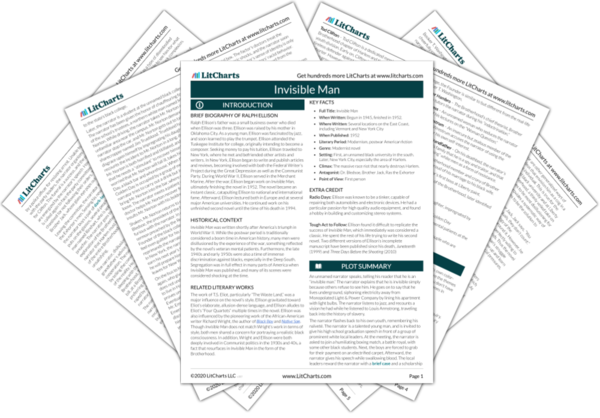Summary
Analysis
The narrator’s room at Men’s House is small and clean. One of the room’s only furnishings is a Gideon Bible. The Bible reminds the narrator of the home, and he thinks both of Dr. Bledsoe and his father’s attempt to establish family prayer.
The bible is a small reminder of the world that the narrator has left behind, the world of his family and of Down South religion. Everything else in New York is almost completely foreign.
Themes
The narrator is proud of the letters from Dr. Bledsoe, and wishes he could show them to someone. He plans to look for a job the next day, settling into a routine and attempting to make the most of his time. At the same time, he remembers Dr. Bledsoe, a remembrance that causes him resentment.
The narrator believes that Dr. Bledsoe, despite punishing him with expulsion, still wishes to help him. Dr. Bledsoe’s letters represent the narrator’s illusion that his hard work and good intentions will naturally help him advance in life.
Themes
The next day, the narrator takes the subway to Wall Street and marvels at the tall buildings. He watches the black messengers taking money across town, and wonders if everything that goes on is being watched. Eventually, the narrator finds the office of the trustee where he intends to deliver his first letter. Nervous and unsure of protocol, the narrator waits outside the office for a while.
On Wall Street, the narrator encounters a place that is a true center of power, far beyond anything he’s seen in the south. The fact that the narrator feels that he’s being watched indicates his awareness of the immense power that operates in New York.
Themes
The narrator enters the office and meets a young secretary. He gives the secretary his letter of introduction, and she takes the letter to another room. Some time later, she reappears and looks at the narrator “oddly.” She informs him that Mr. Bates, the first trustee, is simply too busy to meet him today, and that he will hear from Mr. Bates by mail. Disappointed, the narrator leaves his address, but is unworried by the incident.
The narrator’s first attempt to use one of Dr. Bledsoe’s letters is a failure, but the inexperienced narrator is still unaware that he will be unable to reach the white leaders of New York. The narrator’s experience is emblematic of the near impossibility of a black man penetrating the closed ranks of the power elite.
Themes
Get the entire Invisible Man LitChart as a printable PDF.

Over the next few days, the narrator delivers letters to several secretaries of the trustees he is supposed to meet. He is not successful in reaching the trustees, but makes little of it. In the afternoons, he explores the city. Mixing for the first time with whites that are uninterested in him, the narrator thinks about the way he conducts himself. He is unsure how to act in his new environment.
The narrator’s first experience is repeated over and over, demonstrating the narrator’s complete isolation from a connection that might help him obtain a job. At the same time, the narrator is gaining experience through his time in New York, learning a new life living among both black and white people.
Themes
After a few days, the narrator becomes impatient with his letters. He has only one more letter to distribute, addressed to a Mr. Emerson. Time is beginning to run short: the narrator knows he needs to a get a job soon to earn enough money for school. Instead of giving the letter to a secretary, the narrator writes a letter to Mr. Emerson, requesting an appointment.
By writing a letter directly, the narrator demonstrates his first lack of faith in the directions of Dr. Bledsoe. It has become apparent to him that Bledsoe’s letters are not so effective as he imagined, and thus he has to begin to find his own way forward.
Themes
The narrator thinks of Mr. Norton, wishing he could see him again. To the narrator it seems like a great deal of time has passed, though it has been less than a month. He writes Mr. Norton a letter that he drafts over and over again, asking to work for him. However, his letter receives no reply.
The narrator’s attempt to reach out to Mr. Norton reveals the farcical nature of Mr. Norton’s idea of “destiny.” Mr. Norton knows nothing of and cares nothing for the narrator’s particular struggle.
Themes
The narrator begins to doubt his plan to get work, despite the encouragement of the secretaries. He distracts himself at the movies, but dreams of his grandfather and grows depressed.
The narrator’s dream of his grandfather is a reminder that he has deceived himself into thinking that white men would help him.
Themes
The narrator senses that he is part of a plan that he doesn’t understand. He imagines that Dr. Bledsoe and Mr. Norton are somehow behind his lack of success in finding a job. The narrator is beginning to grow desperate, as his money is running low. He doesn’t even have the money for the train fare home. He tells himself to have faith, and that something good will happen the next day. On cue, he receives a letter from Mr. Emerson.
The narrator begins to grow consciously skeptical of Dr. Bledsoe’s “help.” However, as an ambitious young man, he cannot help but believe that something will go his way. Eventually, he receives the small chance that he believes will allow him to continue forward in New York.
Themes












